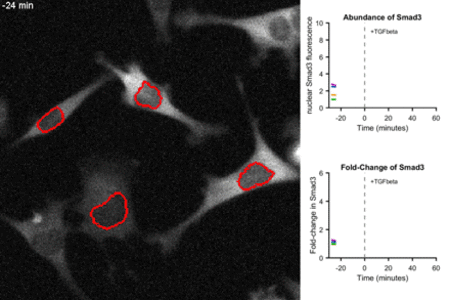Cells calculate ratios to control gene expression

In multicellular animals, cells communicate by emitting and receiving proteins, a process called signaling. One of the most common signaling pathways is the transforming growth factor b (Tgf-b) pathway, which functions in all animal species throughout their lifetimes and regulates numerous biological processes, such as instructing cells how to differentiate—whether a stem cell will become a muscle cell or a bone cell, for example.
But how do cells decipher those signals and use that information to guide gene expression? The answer, according to new research from the laboratory of Lea Goentoro, assistant professor of biology at Caltech: the cells perform simple division. In other words, they do math.
The findings, which appear in a paper in the April 4 issue of Proceedings of the National Academy of Sciences, contradict previous hypotheses about how cells interpret signals. The work was led by Christopher Frick, a graduate student in biochemistry and molecular biophysics.
"Malfunctions in the Tgf-b pathway have been implicated in many types of cancer, and that's why it's important for us to study how it works, to understand how cells use this pathway to take information from their environment and turn it into altered gene expression," Goentoro says. "We found that cells are able to monitor the abundance of a certain protein over time and somehow divide the abundance after the Tgf-b signal by the abundance before the signal. The cell then uses this ratio to adjust gene expression accordingly."
The cell's detection of the Tgf-b signal triggers a series of molecular interactions, culminating in changes in the abundance of a protein called Smad3. A kind of messenger, Smad3 is activated at the cell membrane when a cell encounters the Tgf-β signal, and ultimately ends up in the nucleus of the cell where it directs gene expression. Biologists have commonly believed that the degree to which gene expression is changed will depend on how much Smad protein is produced after exposure to Tgf-β.
In order to study how Smad responds to Tgf-b in real time, the researchers made movies of the signaling process in individual cells. They discovered that the pathway did not behave as biologists had previously thought. After exposure to the Tgf-b signal, the researchers found, Smad3 did indeed move to the nucleus, as expected. The surprise was that the abundance of Smad3 was significantly different in each cell. And yet, despite those wildly varying concentrations of Smad3, the level of Smad3 after the signal divided by the level before the signal was consistent in each cell.
This observation led the researchers to hypothesize that cells are somehow able to compute this ratio and that the gene response is proportional to this relative change (called a fold-change) rather than to the abundance of Smad3.
To test this, the researchers measured target gene expression in cells and compared how it correlated with both the abundance of Smad3 as well as the fold-change of Smad3. Indeed, they found that the target gene expression depended only on the ratio of Smad3 and not on how much Smad3 a cell had.
"Prior to this work, researchers trying to characterize the properties of a tumor might take a slice from it and measure the total amount of Smad in cells," says Goentoro. "Our results show that to understand these cells one must instead measure the change in Smad over time."
"This result is nonintuitive: it is easy to imagine how a cell can increase the expression of a target gene by increasing the abundance of Smad3," says Frick. "Thus, many of us had expected that the abundance of Smad3 would be tuned in response to the Tgf-β signal. In contrast, what these cells regulate is the ratio of the change in abundance of Smad3. The big question now is: How does a cell compute this ratio and then adjust gene expression accordingly?"
The paper is titled "Sensing relative signal in the Tgf-β/Smad pathway."
More information: Christopher L. Frick et al. Sensing relative signal in the Tgf-β/Smad pathway, Proceedings of the National Academy of Sciences (2017). DOI: 10.1073/pnas.1611428114
Journal information: Proceedings of the National Academy of Sciences
Provided by California Institute of Technology


















